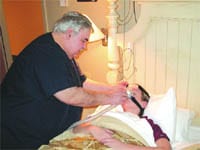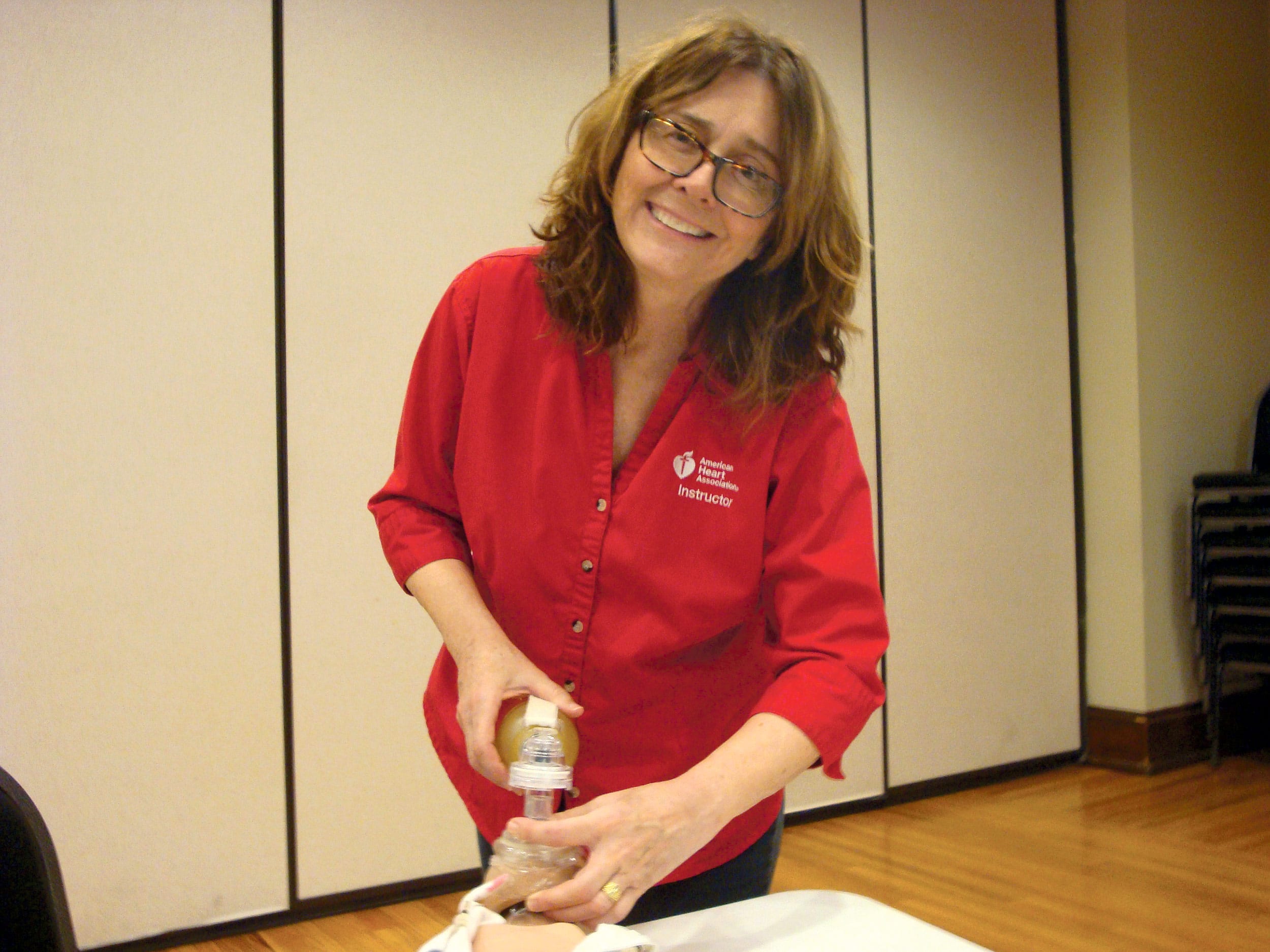The Rest of the Story Why Sleep Medicine Has Become Big Business
When it comes to sleep medicine, people are … well, waking up.
“Before I got into this field, in 1989, I remember vividly going to an educational conference,” said Jim Evitts, clinical manager of Total Sleep at Mercy Medical Center. “They thought, first of all, that women didn’t have sleep problems, except the occasional insomnia, and 0.1{06cf2b9696b159f874511d23dbc893eb1ac83014175ed30550cfff22781411e5} of the working population of men had sleep apnea. Obviously, the demographics of people with sleep apnea were tremendously underestimated.”
That was the year Mercy opened its sleep lab, a year after Baystate Medical Center launched its own sleep program. Today, virtually every hospital in the region — including Holyoke Medical Center, Cooley Dickinson Hospital, Noble Hospital, Berkshire Medical Center, and Wing Memorial Hospital — has a sleep lab on site or is affiliated with one in the community.
And they’re busy — partly due to a growing awareness in the medical community and among patients of how sleep disorders affect their long-term health and quality of life, said Dr. Mohammad Bajwa, an internist who has an office on the Holyoke Medical Center campus.
“We have a large backlog of patients to be tested,” Bajwa said of the hospital’s sleep lab. “We try to be efficient, but our waiting period is two to three months, and many other area sleep labs have similar or even longer waiting periods. There are people establishing sleep labs in commercial buildings and hotels.”
Still, there’s plenty of room for further growth in the field.
“People are more aware, but we still see a lot of undiagnosed cases,” he said. “I think some people are just pushing it under the blanket and not coming in until they have some mishap, or their family members really pressure them to come in. Also, it still has not become standard practice for doctors to ask patients about their sleep history, but over the past 10 years, it’s getting more and more common.”
In other words, whether it’s sleep apnea, insomnia, narcolepsy, or some other sleep disorder, individuals are more likely than ever to seek help. This month, The Healthcare News examines why this is good news.
Breathing Room
Evitts explained that most people come to the sleep lab complaining of tiredness during the day, or else their partner has noticed that the patient stops breathing while asleep — a sure sign of apnea, a condition that blocks the airway and prevents someone from reaching restorative levels of sleep. “By far, the majority of the people we see in the sleep lab are those in the category of sleep-disordered breathing — sleep apnea, things that disrupt the flow of sleep.”
And those conditions can pose serious risks if left untreated.
“People are at much higher risk of accidents while driving and in their place of work,” Bajwa said. “They may also suffer from lack of concentration in school and lack of performance in the workplace. Also, sleep apnea and insufficient sleep are now well-recognized to be associated with high blood pressure and diabetes. Depression is very common — temperamental issues, abnormal temper. If someone has a tendency toward these conditions, having sleep apnea can make it 10 times worse.”
When a patient is referred to a sleep study, Evitts explained, they typically spend the night in the lab, wired from their head to their calves to monitor three main categories of bodily function as they sleep: a neurological assessment, a cardiopulmonary assessment that tracks the heart and breathing functions, and limb movement, which helps the technician diagnose or rule out conditions like restless leg syndrome.
“Based on the results of that baseline study, we determine the therapeutic avenue to take from there,” he told The Healthcare News. “Maybe you’ll try a CPAP, or surgery, or a dental device, or some sort of lifestyle change that may help them treat the problem.” Other options, depending on the condition, might range from medications to cognitive behavioral therapy.
The commonly prescribed CPAP (which stands for continuous positive airway pressure) employs a mask over the face or nose which blows air into the mouth and throat, keeping the airways open during sleep. The device has always confounded a percentage of patients who can’t tolerate the air flow, but that number has gone down in recent years with more comfortable mask design and features that gradually increase the air pressure instead of starting at full blast.
“For a long time, there weren’t better products out there,” Evitts said, but the amount of research going into sleep medicine over the past 20 years, and rising awareness of conditions such as apnea, have changed that. “The market’s bigger, so there’s more money to be made” — hence, the flood of new products.
“Most people who use a CPAP find the difference to be day and night,” Bajwa said. “There are a few individuals who cannot get used to the mask no matter what you do, and with those individuals I often stress losing weight; if there is significant weight reduction, it will definitely reduce the severity of sleep apnea. For those unable to lose weight, then we have to look into other physical and oral devices. The worst-case scenario is a tracheotomy, a permanent hole in the neck. They will keep that hole closed during the daytime and open it up at night.”
Drift Away
Baystate Health has been at the forefront of rising demand for sleep-medicine services, boasting 14 testing rooms at Baystate Medical Center and a total of 20 beds across its three-hospital system.
“One thing we’re proud of is our nationally recognized sleep-center design that has set the standard and raised the bar across the country,” said Rob Hayden, Baystate’s director of Neurosciences and Rehabilitation Services. “Very rarely, when you build a sleep center, do you literally start from scratch. Most places fit themselves into a medical office building or utilize a hotel room, none of which is equipped to monitor sleep. At Baystate, we started from a blank slate and built rooms for this purpose.”
They include extra-thick walls to reduce noise, an exhaust system that exchanges the air in each room 14 times an hour, a color scheme on the walls designed to promote relaxation, high-tech cameras and screens monitoring all the rooms, and two-way, hands-free communications between the patient and the technician outside the room.
Hayden also praised Baystate’s multidisciplinary team of specialists who work with its sleep program, representing neurology, cardiology, pulmonology, and pediatrics, among others, who ensure that patients can find answers to their sleep issues more conveniently than being referred to other sites. “It’s all about the people,” he said. “The fact that all these specialists combine together in this program is what makes it so great.”
They all recognize, he said, that nighttime issues can have a severe impact during all hours of the day — and can shorten lifespans. “People with sleep disorders have a higher incidence of obesity, cardiovascular disease, all sorts of things,” he said.
But someone does not have to be diagnosed with a medical condition to sleep poorly, Evitts said. Too many Americans simply choose not to get enough sleep, and that, too, can wreak havoc on one’s health.
“A lot has been written about Americans’ sleep time, which has continually shrunk since Edison invented the lightbulb,” he said. “The average American is still getting around seven hours of sleep a night, but it’s getting closer to six hours. We’re working later and staying up later. There’s more visual stimuli; the TV stays on past 11:30. People are working on their laptops right up to bedtime, and they can’t get to sleep. It snowballs.”
Bajwa agreed that sleep deficiency is a growing national problem, often observed in professionals who work long hours, teenagers who sleep on an erratic schedule, and people with chronic pain issues, whose discomfort or the drugs they use to treat pain interfere with restful sleep.
“Even in healthy people, lack of sleep is becoming more and more common, and that problem contributes to many diseases,” he said.
Older and Wiser
It’s not just young people who are feeling the effects, Evitts said.
“As we age, our sleep changes, and the Baby Boomers are aging,” he said. “A lot of things are tied into sleep, from cognitive abilities to memory problems to fatigue during the day. And this generation of older people isn’t like the generation before, the shuffleboard type. They’re energetic. I see a lot of people in their late 70s and 80s, and they’re active, and they want to stay active.”
What many of them don’t realize, however, is that sleep deprivation slices into that energy and leads to sleep disturbances, and the need for adequate sleep every night only becomes more important in those senior years.
“Sleep is tied into things like productivity, things like depressive disorders,” Evitts said, noting that sleep medicine is still in its infancy, and doctors — and patients — are always learning more about the impact of sleep (and the lack of it) on their bodies and minds.
“REM sleep was only discovered in the 1950s, at Stanford,” he said. “There’s still a tremendous amount that isn’t known about sleep. We still don’t know exactly what happens during sleep that revitalizes the body; I think that will be the next great breakthrough in sleep.”
Until then, people throughout Western Mass. and across the country will continue to file into sleep labs, doze off covered with wires — and, hopefully, wake up to a better life.


